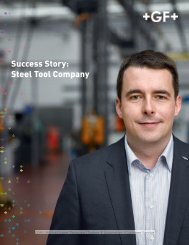Martin Guitar
Create successful ePaper yourself
Turn your PDF publications into a flip-book with our unique Google optimized e-Paper software.
Success Story:<br />
<strong>Martin</strong> <strong>Guitar</strong><br />
EDM I Milling I Laser Texturing I Tooling & Automation I Customer Service
<strong>Guitar</strong> Maker Finds Surprising Benefits from Metalcutting<br />
Innovations<br />
Sometimes solutions are found in very unlikely places.<br />
Technologies can end up providing substantial benefit well<br />
outside the area of application for which they were originally<br />
developed. In just such a case, a world-famous guitar manufacturer<br />
found that metalcutting innovations created by GF<br />
AgieCharmilles were perfectly suited to boost productivity<br />
when working with wood.<br />
With 175 years of history behind it, <strong>Martin</strong> <strong>Guitar</strong> has long<br />
produced the acoustic guitar of choice for some of most<br />
renowned musicians of our time. Elvis, Eric Clapton, Johnny<br />
Cash, Tom Petty, Willie Nelson, Sting, Jimmy Buffet and Paul<br />
Simon are just a few of the legendary guitarists to make music<br />
history on a <strong>Martin</strong>. The company’s influence continues today,<br />
with prominent artists such as Beck, Dave Matthews, John<br />
Mayer and Jonny Lang relying on the quality of <strong>Martin</strong> guitars<br />
to convey their music to the world.<br />
Above everything, <strong>Martin</strong>’s success has stemmed from an<br />
undying commitment to quality. The company treats its manufacturing<br />
processes as an art form, with many manual operations<br />
that employees spend years mastering and perfecting.<br />
Any change to the production processes is undertaken with<br />
the utmost caution.<br />
“We will not sell a guitar unless we are absolutely sure that it<br />
meets our rigorous quality requirements,” says Fred Walters,<br />
engineering project manager at <strong>Martin</strong> <strong>Guitar</strong>. “We view our<br />
reputation as being on the line with every guitar we make, so<br />
there is no room for compromise. This means our production<br />
processes have to be as close to perfect as possible, as we<br />
simply do not allow the production or sale of any second quality<br />
guitars.”<br />
While most manufacturers avoid the production of seconds for<br />
obvious reasons, <strong>Martin</strong> <strong>Guitar</strong> is especially mindful of it. With<br />
guitars, different woods produce dramatically varying levels<br />
of sound quality. The tonal woods that offer the best sounding<br />
results are in increasingly short supply and quite costly to<br />
acquire.<br />
This makes Mr. Walters’ job extremely challenging. As engineering<br />
project manager, his responsibilities include identifying<br />
potential new processes and meticulously evaluating<br />
whether they can be successfully integrated without affecting<br />
the quality of the finished product. Typically, processes requiring<br />
extensive physical labor receive the most attention, as they<br />
tend to be the most time-consuming and can be exhausting<br />
for employees.<br />
In searching for ways to streamline the manufacturing process,<br />
significant inefficiency was discovered in the method for<br />
installing frets on a guitar’s neck. Fret slots were cut all the<br />
way across, from one end of the fingerboard to the other. The<br />
metal fret was then installed and trimmed to be flush with the<br />
guitar’s neck. This would leave an opening under the fret, between<br />
the metal and wood, that would have to be hand-filled<br />
with glue, which then required 24 hours of drying time. Finally,
excess glue was removed by hand, to achieve a smooth, unbroken<br />
surface along the edge of the neck.<br />
“This process created somewhat of a bottleneck in our fretting<br />
operation,” says Mr. Walters. “In evaluating the process,<br />
we knew that pocketed fret slots would allow us to produce<br />
the same or possibly improve the quality of our guitar neck,<br />
without the manual application of glue and associated waiting<br />
time for drying. Unfortunately, we hadn’t found a viable solution<br />
for machining the pockets.”<br />
Pocketed fret slots needed to be 0.135” deep and just 0.022”<br />
wide. <strong>Martin</strong> <strong>Guitar</strong> possessed several vertical machining<br />
centers with a maximum spindle speed of 15,000 rpm. The<br />
machines could produce the pockets, but required 69 seconds<br />
per slot, translating into 23 minutes to finish one board.<br />
Also, the diameter-to-depth ratio resulted in unreliable tool<br />
performance with frequent failure. Realizing that its machines<br />
lacked the levels of performance needed to update the<br />
process, the company contacted Holco, Inc., its distributor for<br />
production and inspection equipment.<br />
were developed for shops working with metal, they have really<br />
improved our operations.”<br />
To get even more out of its investment, <strong>Martin</strong> <strong>Guitar</strong> has<br />
started using the HSM 800 for the pearl inlays on its guitar<br />
fingerboards, bridges and headplates. Taking advantage of the<br />
machine’s high precision, <strong>Martin</strong> cuts both wood and pearl to<br />
ensure that the two pieces fit together seamlessly. Accuracy is<br />
extremely important to the application, as even a slight mismatch<br />
means that the parts will not fit together correctly.<br />
“We’re constantly looking for other ways to take advantage of<br />
the capabilities of the Mikron machine,” says Mr. Walters. “It’s<br />
cutting edge technology and we’ll always look for unique ways<br />
to apply it.”<br />
<strong>Martin</strong> <strong>Guitar</strong> is proof of the value in thinking outside the box<br />
when considering the application of new technologies. That is<br />
a lesson that all manufacturers should take to heart, regardless<br />
of the materials they use or the products they produce.<br />
“For the size of cut the pocketed fret slots required, they<br />
needed a machine with high cutting speeds and a high performance<br />
spindle with virtually no run-out,” says Scott Conti,<br />
the Holco sales representative that works with <strong>Martin</strong> <strong>Guitar</strong>.<br />
“It was a wood cutting application, but it was really calling<br />
out for the innovations that have been made in metalworking<br />
machines. Once we started thinking outside the box in that<br />
regard, we found the solution.”<br />
The suggested solution came in the form of a Mikron HSM 800<br />
from GF Agie Charmilles. The machine’s high-speed spindle<br />
operates at a maximum speed of 42,000 rpm and, coupled<br />
with high feed rates, provides the required levels of performance<br />
needed to cut the pockets without snapping tools.<br />
<strong>Martin</strong> <strong>Guitar</strong> provided sample materials for test cuts and<br />
found that the results were favorable enough to justify ordering<br />
the machine.<br />
After installing the HSM 800, <strong>Martin</strong> <strong>Guitar</strong> worked to optimize<br />
cutting speeds and feeds. Depending on the specific material<br />
being machined, cutting speeds vary between 30,000 rpm and<br />
38,000 rpm and feed rates of 325 IPM to 475 IPM are used.<br />
While it would take 23 minutes to machine a single board on<br />
the old machining centers, the HSM 800 can machine pocketed<br />
fret slots in just 9.6 seconds each, translating to 3 minutes<br />
5 seconds per board. This eliminated approximately 87%<br />
of the machining time. Additionally, with the elimination of<br />
run-out, tool life was increased and the process achieved the<br />
level of stability needed to eliminate the chances of producing<br />
scrap.<br />
“By finding a reliable way to produce pocketed fret slots, we’ve<br />
been able to do away with the gluing process required with<br />
the old way of installing frets,” says Mr. Walters. “In addition<br />
to removing a bottleneck from production, it’s resulted<br />
in approximately $40,000 per year in cost savings. Also, with<br />
the pocketed fret slot we no longer have the thru slot showing<br />
on the edge of the fingerboard, so the look and feel of the<br />
neck is improved as well. While the innovations we’re using
GF Machining Solutions<br />
GF Machining Solutions<br />
560 Bond Street<br />
Lincolnshire, IL, 60069<br />
USA<br />
Website: www.gfms.com/us<br />
Email: info.gfms.us@georgfischer.com<br />
Phone: 847-913-5300<br />
© Machining Solutions, 2015<br />
The technical data and illustrations are not binding.<br />
They are not warranted characteristics and are<br />
subject to change.<br />
Facebook: facebook.com/gfmachiningsolutions<br />
Twitter: twitter.com/gfms_us<br />
YouTube: youtube.com/agiecharmilles<br />
Version 1.1
















